SUZUKI GRAND VITARA 1987 Service Owners Manual
Manufacturer: SUZUKI, Model Year: 1987, Model line: GRAND VITARA, Model: SUZUKI GRAND VITARA 1987Pages: 962, PDF Size: 27.87 MB
Page 91 of 962

Measured journal diameter
44.744 - 44.750 mm44.738 - 44.744 mm44.732 - 44.738 mm
(1.7616 - 1.7618 in.)(1.7614 - 1.7616 in.)(1.7612 - 1.7614 in.)
Alphabets stamped I AGreen & RedBlack & RedRed only
on mating surfaceBBlack & RedRed onlyYellow & Red
of cylinder blockCRed onlyYellow & RedBlue & Red
Undersize bearing to be installed.
Rear Oil Seal
Carefully inspect oil seal for wear or damage. If
its lip is worn or damaged, replace oil seal.
1. Rear oil seal
Fig. 3-5-49 Rear oil sealOil Pump
Flywheel
l If ring gear is damaged, cracked or worn,
replace flywheel.
l If surface contacting clutch disc is damaged,
or excessibly worn, replace flywheel.
l Check flywheel for face runout with a dial
wge.
If runout is out of limit, replace flywheel.
Limit on runout0.2 mm (0.0078 in.)
Fig. 3-5-50 Measuring runou t
1) Inspect oil seal lip for fault or other damage.
Replace as necessary.
2) Inspect outer and inner rotors, rotor plate,
and oil pump case for excessive wear or
damage.
l Radial clearance:
Check radial clearance between outer rotor
and case, using thickness gauge.
If clearance exceeds its limit, replace outer
rotor or case.
Outer rotor and case0.310 mm (0.0122 in.)
3-34
Page 92 of 962

3-6. ENGINE REASSEMBLY
NOTE:
l All parts to be used in reassembly must be
perfectly clean.
l Oil sliding and rubbing surfaces of engine
parts just before using them in reassembly.
Use engine oil (Refer to page l-8).
l Have liquid packing ready for use. SUZUKI
BOND NO. 1215 is specified for it. Use it
wherever its use is specified in order to
ensure leak-free (oil and water) workmanship
of reassembly.
l There are many running clearances. During
the course of engine reassembly, be sure to
check these clearances, one after another,
as they form.
l Gaskets, “0” rings and similar sealing mem-
bers must be in perfect condition. For these
members, use replacement parts in stock.
l Tightening torque is specified for impor-
tant fasteners - mainly bolts and nuts -of
the engine and other components. Use torque
wrenches and constantly refer to the specified
values given on p. 3-58.
l Do not disregard match marks provided on
parts. Some of them are those given at the
time of disassembly.
l There are many sets of parts. Crankshaft
bearings, connecting rods, pistons, etc., are
in combination sets. Do not disturb such
combinations and make sure that each part
goes back to where it came from.
Engine reassembly is the reverse of engine disas-
sembly as far as sequence is concerned, but
there are many reassembling steps that involve
measures necessary for restoring engine as close
to factory-assembled condition as possible. Only
those steps will be dealt with here.
Fig. 3-5-51 Radial clearances
l Side clearance:
Using straight edge and thickness gauge,
measure side clearance.
Limit on side
clearance0.15 mm (0.0059 in.)
Fig. 3-5-52 Side clearance measurement
Timing Belt end Tensioner
l Inspect timing belt for wear or crack. Replace
it as necessary.
l Inspect tensioner for smooth rotation.
3-35
Page 93 of 962
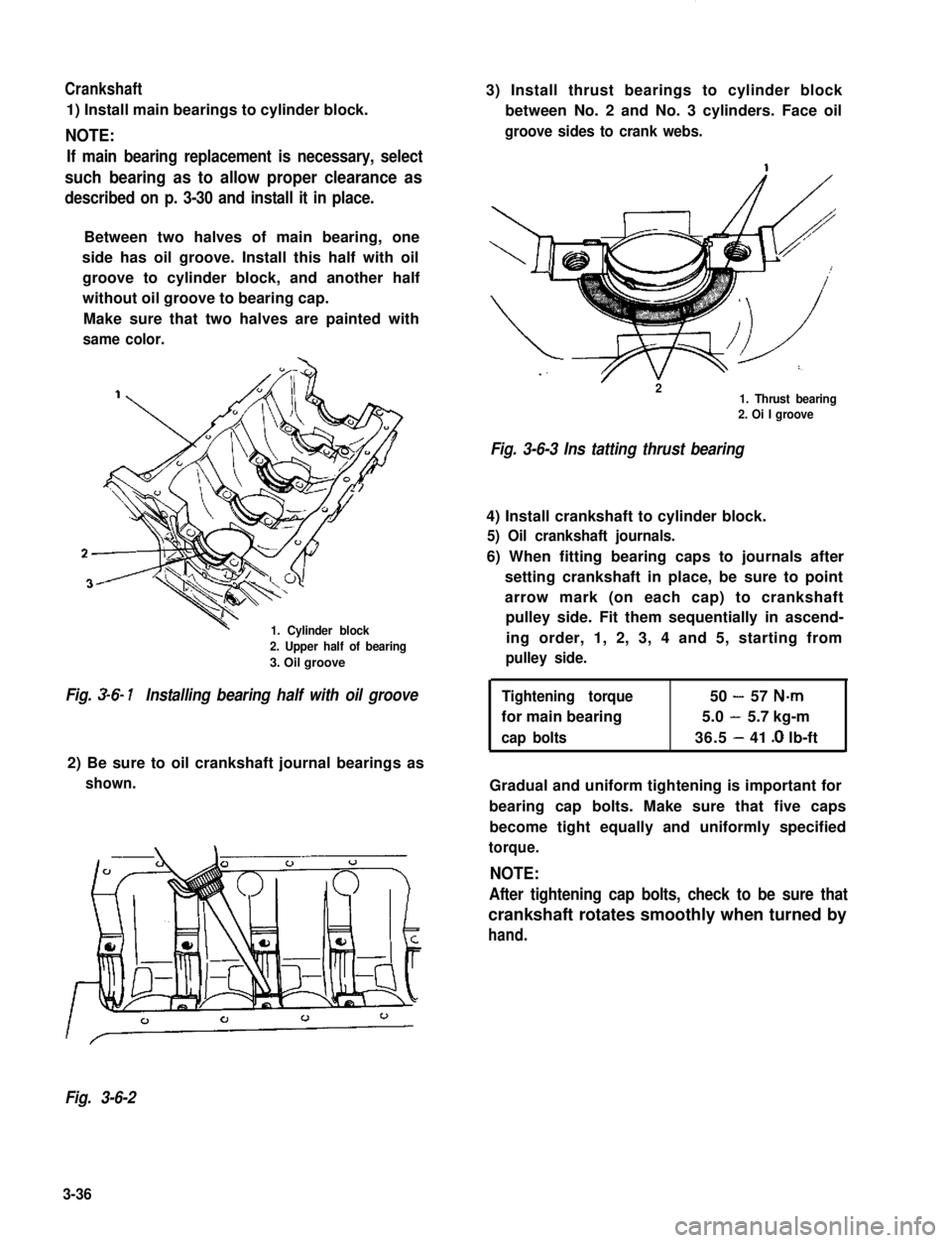
Crankshaft
1) Install main bearings to cylinder block.
NOTE:
If main bearing replacement is necessary, select
such bearing as to allow proper clearance as
described on p. 3-30 and install it in place.
Between two halves of main bearing, one
side has oil groove. Install this half with oil
groove to cylinder block, and another half
without oil groove to bearing cap.
Make sure that two halves are painted with
same color.
1. Cylinder block
2. Upper half of bearing
3. Oil groove
3) Install thrust bearings to cylinder block
between No. 2 and No. 3 cylinders. Face oil
groove sides to crank webs.
r21. Thrust bearing2. Oi I groove
Fig. 3-6-3 Ins tatting thrust bearing
4) Install crankshaft to cylinder block.
5) Oil crankshaft journals.
6) When fitting bearing caps to journals after
setting crankshaft in place, be sure to point
arrow mark (on each cap) to crankshaft
pulley side. Fit them sequentially in ascend-
ing order, 1, 2, 3, 4 and 5, starting from
pulley side.
Fig. 3-6- 1Installing bearing half with oil grooveTightening torque50-57 N-m
for main bearing5.0-5.7 kg-m
cap bolts36.5-41 .O lb-ft
2) Be sure to oil crankshaft journal bearings as
shown.Gradual and uniform tightening is important for
bearing cap bolts. Make sure that five caps
become tight equally and uniformly specified
torque.
NOTE:
After tightening cap bolts, check to be sure that
crankshaft rotates smoothly when turned by
hand.
Fig. 3-6-2
3-36
Page 94 of 962
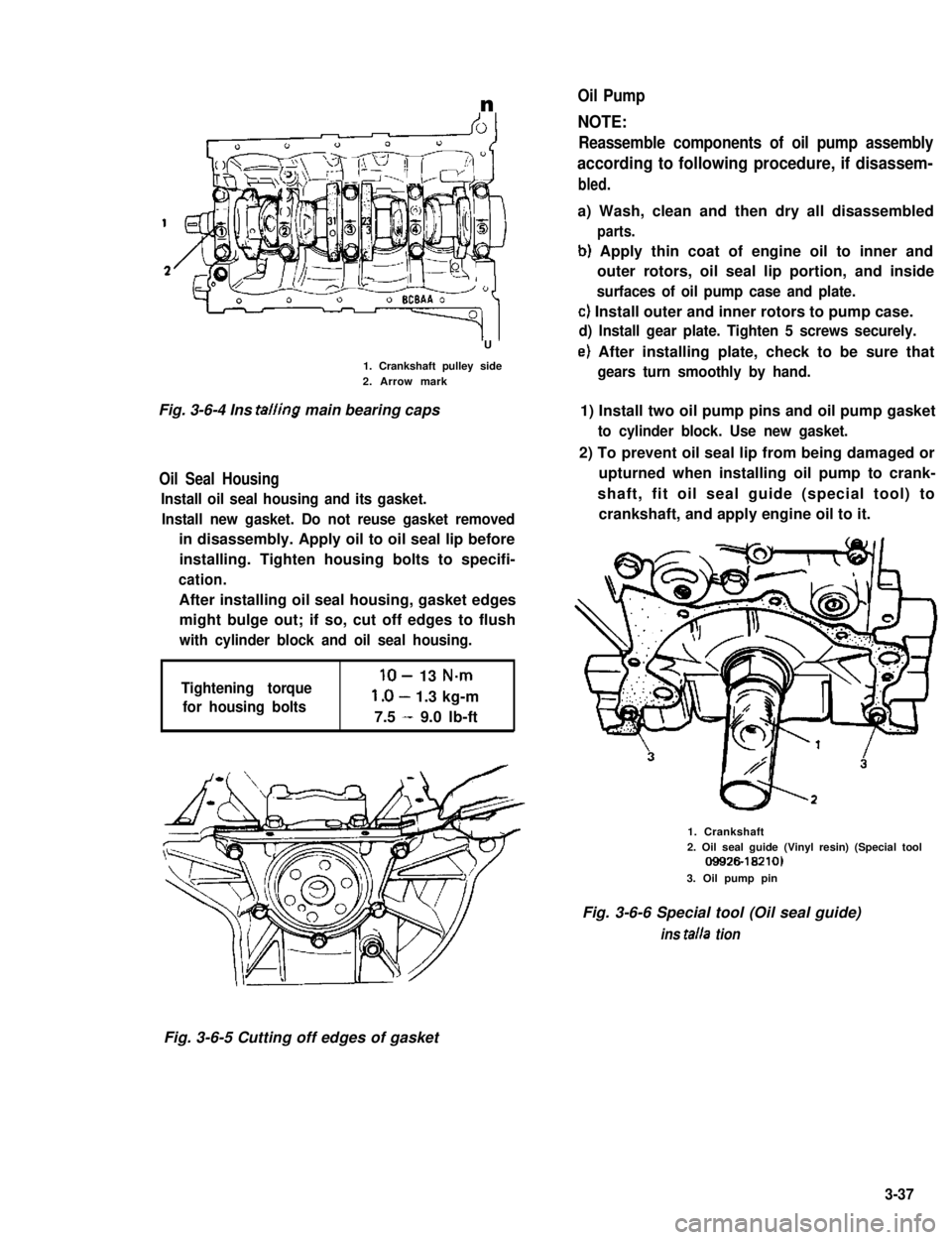
n
U
1. Crankshaft pulley side2. Arrow mark
Fig. 3-6-4 Ins tailing main bearing caps
Oil Seal Housing
Install oil seal housing and its gasket.
Install new gasket. Do not reuse gasket removed
in disassembly. Apply oil to oil seal lip before
installing. Tighten housing bolts to specifi-
cation.
After installing oil seal housing, gasket edges
might bulge out; if so, cut off edges to flush
with cylinder block and oil seal housing.
Tightening torque
for housing bolts
lo- 13 N-m
l.O- 1.3 kg-m
7.5 - 9.0 lb-ft
Oil Pump
NOTE:
Reassemble components of oil pump assembly
according to following procedure, if disassem-
bled.
a) Wash, clean and then dry all disassembled
parts.
b) Apply thin coat of engine oil to inner and
outer rotors, oil seal lip portion, and inside
surfaces of oil pump case and plate.
c) Install outer and inner rotors to pump case.
d) Install gear plate. Tighten 5 screws securely.
e) After installing plate, check to be sure that
gears turn smoothly by hand.
1) Install two oil pump pins and oil pump gasket
to cylinder block. Use new gasket.
2) To prevent oil seal lip from being damaged or
upturned when installing oil pump to crank-
shaft, fit oil seal guide (special tool) to
crankshaft, and apply engine oil to it.
1. Crankshaft2. Oil seal guide (Vinyl resin) (Special tool09926-18210)
3. Oil pump pin
Fig. 3-6-6 Special tool (Oil seal guide)
ins talla tion
Fig. 3-6-5 Cutting off edges of gasket
3-37
Page 95 of 962
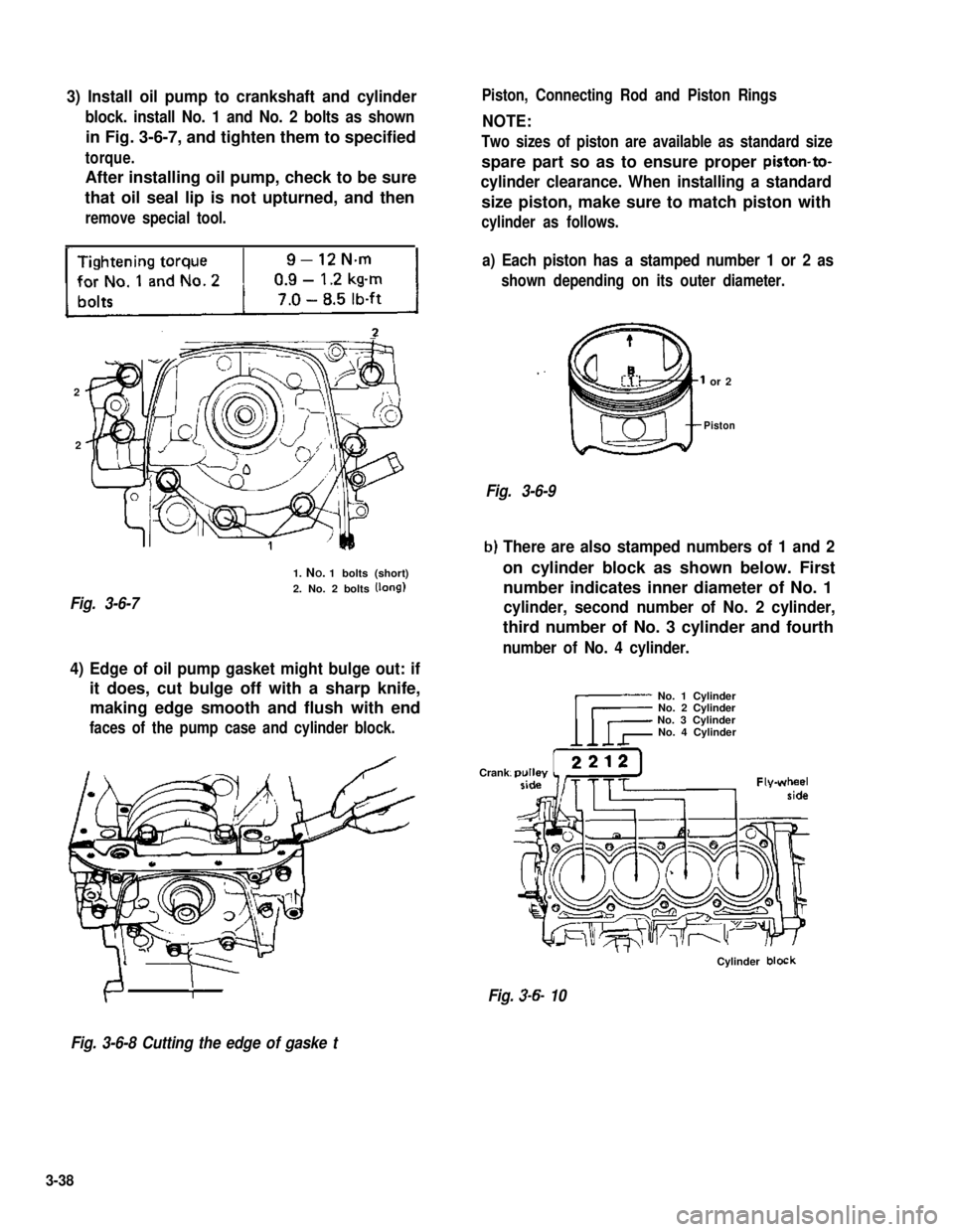
3) Install oil pump to crankshaft and cylinder
block. install No. 1 and No. 2 bolts as shown
in Fig. 3-6-7, and tighten them to specified
torque.
After installing oil pump, check to be sure
that oil seal lip is not upturned, and then
remove special tool.
-
2
2
Fig. 3-6-7
1. NO. 1 bolts (short)
2. No. 2 bolts (long)
Piston, Connecting Rod and Piston Rings
NOTE:
Two sizes of piston are available as standard size
spare part so as to ensure proper piston-to-
cylinder clearance. When installing a standard
size piston, make sure to match piston with
cylinder as follows.
a) Each piston has a stamped number 1 or 2 as
shown depending on its outer diameter.
or 2
Piston
Fig. 3-6-9
b) There are also stamped numbers of 1 and 2
on cylinder block as shown below. First
number indicates inner diameter of No. 1
cylinder, second number of No. 2 cylinder,
third number of No. 3 cylinder and fourth
number of No. 4 cylinder.
4) Edge of oil pump gasket might bulge out: if
it does, cut bulge off with a sharp knife,
making edge smooth and flush with end
faces of the pump case and cylinder block.
Crank
No. 1 CylinderNo. 2 CylinderNo. 3 CylinderNo. 4 Cylinder
Cylinder block
Fig. 3-6- 10
Fig. 3-6-8 Cutting the edge of gaske t
3-38
Page 96 of 962
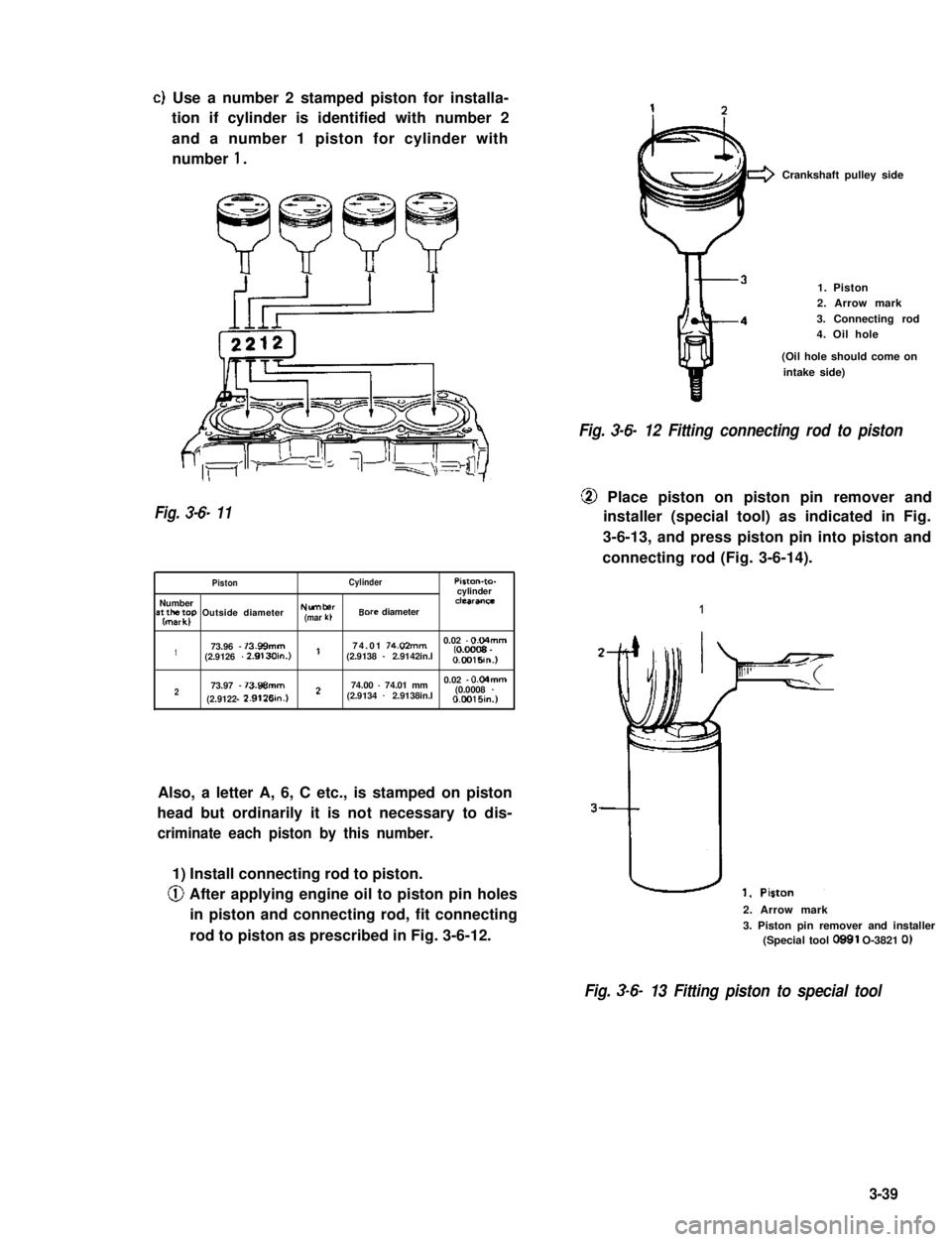
clUse a number 2 stamped piston for installa-
tion if cylinder is identified with number 2
and a number 1 piston for cylinder with
number 1.
Fig. 3-6- 11
PistonCylinderPiston-to-cylinderNumbera;$;r$p Outside diameterNWtlberck?arancE
(mar kbBore diameter
173.96 - 73.99mm’74.01 74.02mm0.02 - 0.04mm
(2.9126 - 2.9130in.)(2.9138 - 2.9142in.l~0.0009 -0.0016in.)
273.97 - 73.96mm74.00 - 74.01 mm0.02 - 0.04mm
2(2.9134 - 2.9138in.l(0.0008 -0.0016in.l
Also, a letter A, 6, C etc., is stamped on piston
head but ordinarily it is not necessary to dis-
criminate each piston by this number.
1) Install connecting rod to piston.
@ After applying engine oil to piston pin holes
in piston and connecting rod, fit connecting
rod to piston as prescribed in Fig. 3-6-12.
Crankshaft pulley side
1. Piston2. Arrow mark
3. Connecting rod4. Oil hole
(Oil hole should come on
intake side)
Fig. 3-6- 12 Fitting connecting rod to piston
@ Place piston on piston pin remover and
installer (special tool) as indicated in Fig.
3-6-13, and press piston pin into piston and
connecting rod (Fig. 3-6-14).
2. Arrow mark
3. Piston pin remover and installer(Special tool 0991 O-3821 0)
Fig. 3-6- 13 Fitting piston to special tool
3-39
(2.9122-
Page 97 of 962
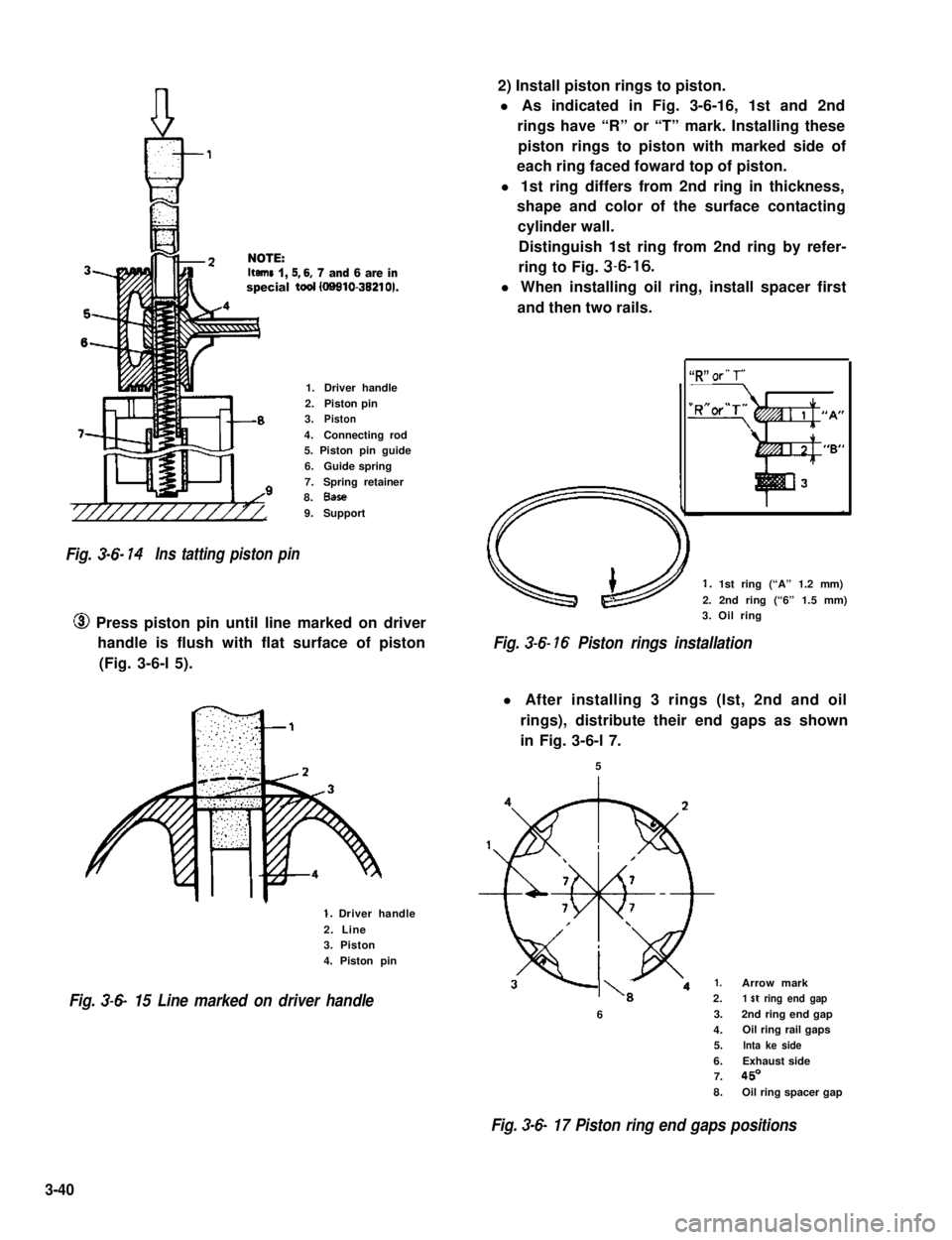
NOTE:1kerns 1, 5,6, 7 and 6 are inspecial tad (09910-36210).
1.Driver handle
2.Piston pin3.Piston
4.Connecting rod5. Piston pin guide
6.Guide spring
7.Spring retainer8.Base
9.Support
Fig. 3-G 14Ins tatting piston pin
@ Press piston pin until line marked on driver
handle is flush with flat surface of piston
(Fig. 3-6-l 5).
1. Driver handle
2. Line3. Piston
4. Piston pin
Fig. 3-6- 15 Line marked on driver handle
2) Install piston rings to piston.
l As indicated in Fig. 3-6-16, 1st and 2nd
rings have “R” or “T” mark. Installing these
piston rings to piston with marked side of
each ring faced foward top of piston.
l 1st ring differs from 2nd ring in thickness,
shape and color of the surface contacting
cylinder wall.
Distinguish 1st ring from 2nd ring by refer-
ring to Fig. 3-6-16.
l When installing oil ring, install spacer first
and then two rails.
“R” or” T”
1. 1st ring (“A” 1.2 mm)
2. 2nd ring (“6” 1.5 mm)3. Oil ring
Fig. 3-6- 16 Piston rings installation
l After installing 3 rings (lst, 2nd and oil
rings), distribute their end gaps as shown
in Fig. 3-6-l 7.
5
1.Arrow mark
I\,
6
2.1 st ring end gap
3.2nd ring end gap
4.Oil ring rail gaps
5.lnta ke side
6.Exhaust side7.450
8.Oil ring spacer gap
Fig. 3-6- 17 Piston ring end gaps positions
3-40
Page 98 of 962

3) install piston and connecting rod assembly
into cylinder bore.
@Apply engine oil to pistons, rings, cylinder
walls, connecting rod bearings and crank-
pins.
@Put guide hoses over connecting rod bolts as
shown in Fig. 3-6-18. These guide hoses
protect crankpin and thread of rod bolt
from damage during installation of connect-
ing rod and piston assembly.
1. Guide hoses
Fig. 3-6- 18 Guide hoses installation
@When installing piston and connecting rod
assembly into cylinder bore, point arrow
mark on each piston head to crankshaft
pulley side.
1. Crankshaft pulley side
2. Flywheel side
Fig. 3-6- 19 Direction of arrow mark on
piston head
@ Use piston ring compressor (Special tool) to
compress rings. Guide connecting rod into
place on the crankshaft.
Using a hammer handle, tap piston head to
install piston into bore. Hold ring compres-
sor firmly against cylinder block until all
piston rings have entered cylinder bore.
1. Piston ring compressor
(Special tool 09916-77310)
Fig. 3-6-20 Installing piston to cylinder
4) Install connecting rod bearing cap.
When installing cap to rod, point arrow mark
on cap to crankshaft pulley side.
Tighten cap nuts to specification.
Tightening torque33-37 N-m
for rod bearing3.3-3.7 kg-m
cap nuts24.0-26.5 lb-ft
1. Bearing cap
2. Arrow mark3. Crankshaft pulley side
4. Cap nut
Fig. 3-6-21Ins tailing bearing cap
3-41
Page 99 of 962
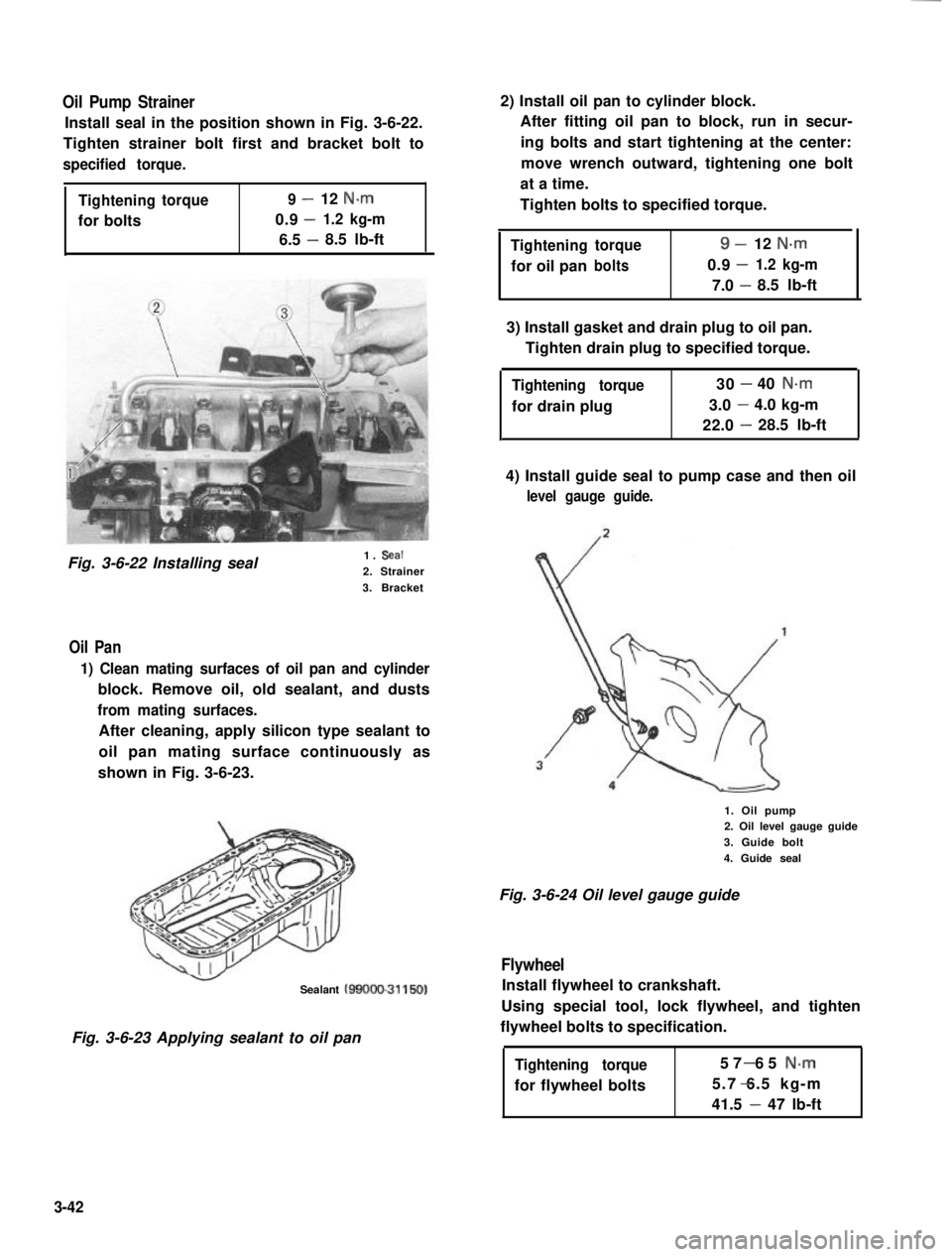
Oil Pump Strainer
Install seal in the position shown in Fig. 3-6-22.
Tighten strainer bolt first and bracket bolt to
specified torque.
Tighteningtorque9-12 N.m
0.9-for bolts1.2 kg-m
6.5 -8.5 lb-ft
Fig. 3-6-22 Installing seal1. Seal
2. Strainer
3. Bracket
Oil Pan
1) Clean mating surfaces of oil pan and cylinder
block. Remove oil, old sealant, and dusts
from mating surfaces.
After cleaning, apply silicon type sealant to
oil pan mating surface continuously as
shown in Fig. 3-6-23.
Sealant MOOO-31150)
Fig. 3-6-23 Applying sealant to oil pan
2) Install oil pan to cylinder block.
After fitting oil pan to block, run in secur-
ing bolts and start tightening at the center:
move wrench outward, tightening one bolt
at a time.
Tighten bolts to specified torque.
Tighteningtorque9-12 N-m
-for oil panbolts0.91.2 kg-m
7.0 -8.5 lb-ft
3) Install gasket and drain plug to oil pan.
Tighten drain plug to specified torque.
Tightening torque
for drain plug
30-40 N.m
3.0-4.0 kg-m
22.0-28.5 lb-ft
4) Install guide seal to pump case and then oil
level gauge guide.
1. Oil pump2. Oil level gauge guide
3. Guide bolt
4. Guide seal
Fig. 3-6-24 Oil level gauge guide
Flywheel
Install flywheel to crankshaft.
Using special tool, lock flywheel, and tighten
flywheel bolts to specification.
Tightening torque
for flywheel bolts
57 65 N-m-
5.7 6.5 kg-m-
41.5 - 47 lb-ft
3-42
Page 100 of 962
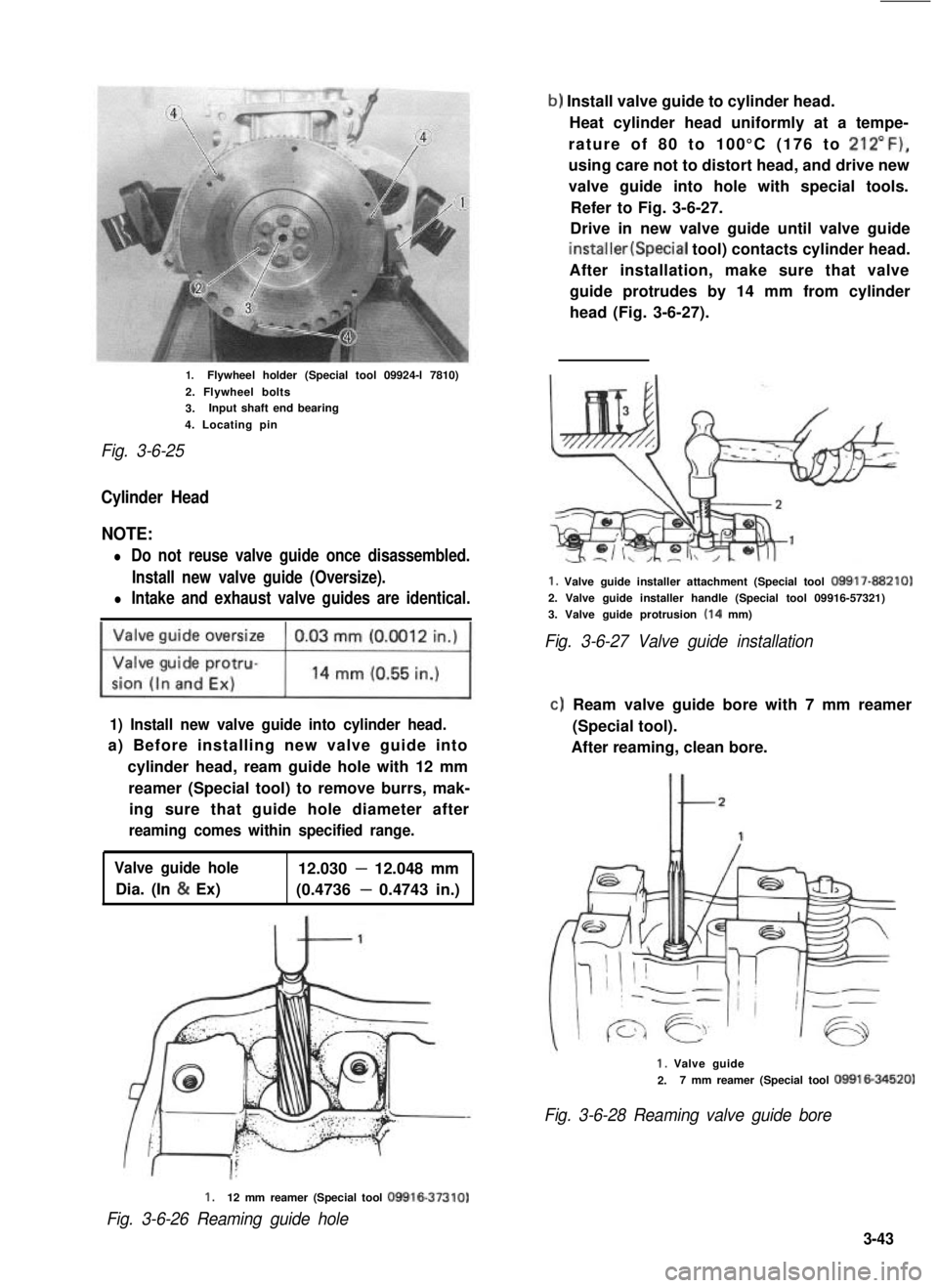
1.Flywheel holder (Special tool 09924-l 7810)
2. Flywheel bolts
3.Input shaft end bearing
4. Locating pin
Fig. 3-6-25
Cylinder Head
NOTE:
l Do not reuse valve guide once disassembled.
Install new valve guide (Oversize).
l Intake and exhaust valve guides are identical.
1) Install new valve guide into cylinder head.
a) Before installing new valve guide into
cylinder head, ream guide hole with 12 mm
reamer (Special tool) to remove burrs, mak-
ing sure that guide hole diameter after
reaming comes within specified range.
Valve guide hole12.030 - 12.048 mm
Dia. (In & Ex)(0.4736 - 0.4743 in.)
b) Install valve guide to cylinder head.
Heat cylinder head uniformly at a tempe-
rature of 80 to 100°C (176 to 212”F),
using care not to distort head, and drive new
valve guide into hole with special tools.
Refer to Fig. 3-6-27.
Drive in new valve guide until valve guide
installer(Special tool) contacts cylinder head.
After installation, make sure that valve
guide protrudes by 14 mm from cylinder
head (Fig. 3-6-27).
1. Valve guide installer attachment (Special tool 09917-88210)
2. Valve guide installer handle (Special tool 09916-57321)
3. Valve guide protrusion (14 mm)
Fig. 3-6-27 Valve guide installation
clReam valve guide bore with 7 mm reamer
(Special tool).
After reaming, clean bore.
1. Valve guide
2.7 mm reamer (Special tool 09916-34520)
Fig. 3-6-28 Reaming valve guide bore
1.12 mm reamer (Special tool 09916-37310)
Fig. 3-6-26 Reaming guide hole
3-43